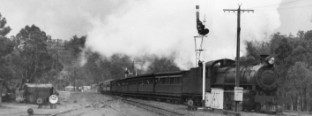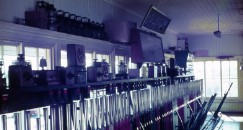Wundowie
WUNDOWIE | |
WAGR - Eastern Railway (E. R.) | |
1938 WAGR MAP Mileage = 41 m 34 ch | |
Location Map | |
Next Down Station: | Next Up Station: |
WERRIBEE | |
Quick Facts |
|
Opened |
Closed |
1907 |
1936 |
Mechanical |
Electrical |
3 Levers |
Winters 2-Position Block |
Fate: Unknown |
|
Wundowie was opened in February 1907 as a block post. It was located near the 53 mile post (ex-Fremantle, as distances were measured prior to 1914) probably at or near the site of the earlier 53 mile siding, about which little appears to have been recorded. Initially known as the 53 mile box, it was built as part of the duplication of the Eastern Railway. Its opening was recorded in Weekly Notice 10 of 1907 (week ending 8th March). The same notice described the facilities as consisting of a siding connected to the Up line by a set of trailing points, this line being protected by a set of catch points with appropriate indicator, and Up and Down Home and Distant signals, all levers worked from a signal cabin. This signal cabin was located in the section Karrijine to Wooroloo, The Safeworking system used at this time was double line block working, using Winters two Position block instruments.
The 53 mile box was located approximately one and a half miles west of Karrijine and east of Wooroloo. At first glance, it seems strange that the WAGR should open a block post located so close to one end of its section. The answer is probably to found by comparing and contrasting the worldview of the WAGR's traffic and civil engineering staff when it came to locating loops and block posts. Karrijine was built as a crossing loop, where obtaining the most level track at the lowest cost (particularly in the hilly country of the Darling Range) was the primary consideration motivating any civil engineer charged with its construction. The lay of the land made Karrijine a much better candidate for a loop than the 53 mile. However, as a block post, Karrijine was not as suitable as the 53 mile, which was located pretty close to the halfway point between the important stations of Wooroloo and Bakers Hill.
Ideally, traffic staff would locate a block post such that trains would take an equal amount of time to clear the sections on both sides of it. The 53 mile box was in much better location than Karrijine to achieve this aim.
Karrijine and the 53 mile box worked together for only a relatively short time. Karrijine was closed in September 1907 (see the Karrijine page) although it reopened for traffic purposes for an unknown period in 1908. As events were to show, Karrijine was not the only box in this region to have multiple opening and closing dates. Wundowie, as the 53 mile box was to become known, was to have multiple closures and openings throughout its life.
The 53 mile box was renamed Wundowi (without the ‘e") on the 1 st November 1907. Following the first closure of Karrijine, it worked with Wooroloo to the west and Bakers Hill to the east, with intermittent working to Karrijine following its temporary re-opening in February 1908. At some stage between 1907 and 1918 Wundowi was renamed "Wundowie", the name that the town and locality has today.
A trailing dead siding ran from the up main with standing room for wagons. Such an arrangement was eminently suitable for a double line section, although the lack of a cross over at Wundowie meant that empty wagons from Perth had to be detached at Bakers Hill or Koojedda, then worked to Wundowie for loading.
In February 1918 Wundowie underwent the first of its several closures. The block instruments were withdrawn, although the relevant Weekly Notice is silent as to whether the box and signals were removed. War time staff shortages may well have seen the box and signals remaining in situ until the return to normal conditions at the end of hostilities. In any event, by 1923 the box and the signals on the down line had been removed.
The 1923 General Appendix records Wundowie’s facilities as consisting of a siding connected to the up main, protected by an Up Home and Distant, all worked from a ground frame which was unlocked by an Annett’s key held at Clackline.
Increased traffic levels saw Wundowie being reopened as a block post in January 1924. Weekly Notice 2 of 1924 announced that Wundowie was to be switched in; unfortunately for the staff involved the boxes opening hours were between the hours of 4pm and 8 am daily. It now worked with the 45 1/4 mile box (later named Koojedda) to the east, and Wooroloo to the west. Presumably, signals on the down had been re-instated, as well as a box, although there is no record of the former until a reference in Weekly Notice 49 of 1925 and no reference at all as to the latter. Over the next 4 years Wundowie was to be opened and closed no less than 5 times, its openings and closures roughly coinciding with the annual wheat harvest seasons.
In May 1928 Wundowie was closed as block post and the signalmen were withdrawn. This seasonal closure is not recorded as being mirrored by an opening later that year. In May 1930 Weekly Notice 19 of 1930 announced that Wundowie was to be closed until further notice, probably a victim of the drastic decline in traffic levels due to the Depression. This state of affairs lasted until March 1935, when it was reopened as a block post, complete with up and down signals. The several references to Up and Down signals in the Weekly Notices recording its re-openings suggest that the Down signals were regularly removed and reinstated. The Up signals, needed to protect the up siding were probably sacrosanct. This re-opening was to be Wundowie’s last. In April 1936, the Signalman was withdrawn for what was to be the last time, his withdrawal coinciding with the introduction of automatic signalling on the down line between Wooroloo and Koojedda.
The introduction of automatic signalling on the down line between Wooroloo and Koojedda in effectively eliminated the need for Wundowie as a block post. Moving empty traffic over the Eastern Railway during the wheat season was a more pressing problem than working traffic in the opposite direction, and in later years keeping as many down trains moving on the line as possible was probably the reason was Wundowie was used as block post. Once automatic signalling on the down line through Wundowie had been opened there was no justification for Wundowie remaining open as a block post.
Despite its closure as a block post Wundowie, and its immediate surrounds, continued to be graced with fixed signals, which, unusually for an intermediate siding consisted of both manual and automatic semaphores. The siding on the up line continued to be worked by double line absolute block working until it was replaced with automatic signalling. This siding continued to be protected by fixed semaphores worked by a ground frame until the siding was equipped with a switchlock as part of the conversion to automatic signalling.
In 1944, in preparation for the construction of the Wundowie pig iron plant, a siding, equipped with a switchlock, was opened on the down line. The opening of the pig iron plant saw drastic changes to Wundowie’s Safeworking arrangements. Wundowie was upgraded to a station, a station master being appointed in 1949. Cross overs to enable Up trains loaded with iron ore from Koolyanobbing (loaded at Southern Cross) were installed; however, the box was not reinstated as one was not needed. Depending on one’s viewpoint, one of the beauties, or curses, of double track automatic signalling is that track circuited switch locks can safely perform simple track switching functions that previously needed manned boxes to perform. Up Trains, far heavier than any that had previously detached wagons at Wundowie when it was a manned block post, could now terminate there and cross the Down main protected by automatic signals acting as semi-automatics, a notion that many a Wundowie signalman shivering through a cold autumn night in the box would have found fantastic.
Following closure of the Eastern Railway in 1966 the section from Wundowie to Spring Hill was retained for about 15 years, however, a new track arrangement to access the pig iron plant was introduced and the old station yard was subsumed by the plant. Today no trace of Wundowie box or the yard remains, and a casual observer passing Wundowie would never know that a signal box with more comebacks than Nellie Melba ever graced the site.
Information researched and interpreted by Justin Smith of the Signalling Interest Group of W. A.
Any additional information or photographs of this signal cabin would be most welcome - please use the e-mail form provided on this page.
Photograph of Track Layout Plan by Justin Smith, courtesy of RHWA Archives
This page is copyright, and permission must be sought from SignallingWA before this page is used for any purpose other than personal education.
WUNDOWIE Employees | ||
This list may not be complete and does not yet include employees who worked here without being appointed. Where an appointment date is unknown, the Weekly Notice (WN) date advising of the appointment or other official documentation, i.e. Certificate of Competency (CC) will be used. | ||
Name | Appointed | Position |
Is a name missing? Please submit any corrections / additions with suitable evidence using the e-mail form above. | ||


